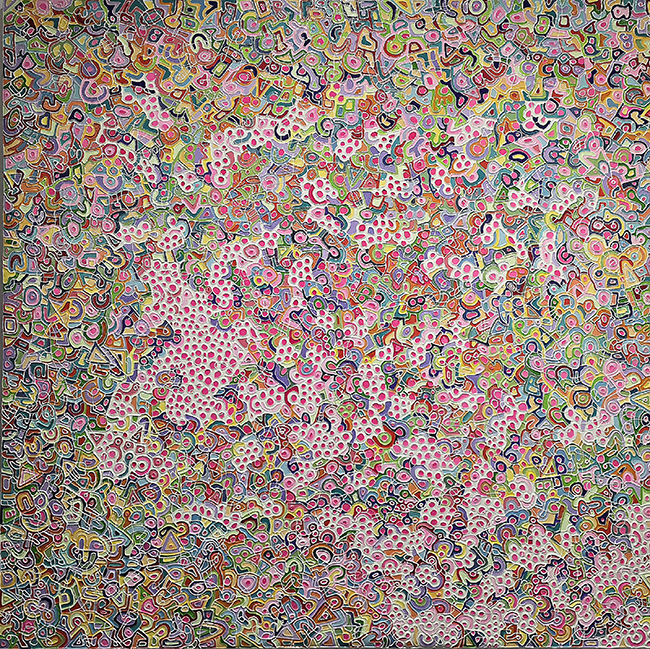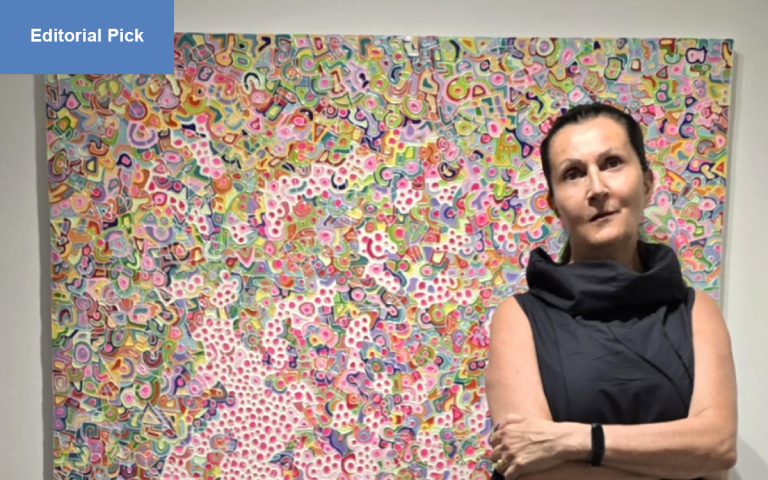Sabrina Puppin is a visual artist whose work doesn’t settle into neat definitions. Her practice is rooted in abstraction, but it’s not distant or cold. Instead, it’s loud, saturated, and emotional. Born in Italy and now working internationally, Puppin’s art has appeared in venues across the globe. Her paintings are bold in color and form—filled with shine, movement, and a kind of overwhelming beauty that feels more like an experience than a static image.

At the center of Puppin’s approach is a fascination with perception. She isn’t trying to mirror reality but rather break it apart, distort it, and reconstruct it from the inside out. Her works don’t rely on traditional subject matter; they rely on feeling. She often refers to her compositions as expressions of daydreams—chaotic, layered, and hyper-visual. Her intent isn’t to illustrate, but to stir something inside the viewer: curiosity, wonder, maybe even a little confusion.
One of her recent pieces, titled Spring Garden, captures this artistic direction with clarity. It’s a mixed media work, measuring 50 by 50 inches, made in 2025. The title hints at something calm, floral, and soft—but the painting delivers a visual jolt instead.
There’s nothing timid about Spring Garden. From the first glance, it pulls you into a frenzy of color. The canvas is packed with layered patterns, mostly circular and organic in nature. These forms overlap, weave into one another, and build a rhythm that feels alive. There’s a motion to the work, as if it’s expanding, spinning, or even breathing. But nothing feels haphazard. Puppin’s chaos is intentional—every dot, every line, every shimmering area seems placed with care.
The surface is saturated with vibrant hues: fuchsia, lime green, electric blue, orange, and violet. These colors don’t fight each other; they’re orchestrated in a way that turns intensity into harmony. There’s a balance in the imbalance. Instead of quiet symmetry or calm landscapes, Puppin chooses excess. The result is visual overload—but not in a negative way. It’s a controlled overload. It wakes the viewer up.
A closer look reveals how much effort went into the layering. The patterns don’t sit flat. They seem to rise and fall, depending on how the light hits them. There’s a tactile quality to the painting—almost as if the surface is alive with texture, although the actual materials used remain elusive. Puppin doesn’t reveal all her techniques, and that ambiguity adds to the intrigue.
The structure of the work is abstract, but it holds hints of nature. The title Spring Garden begins to make sense—not in a literal way, but in how the work feels. There’s the bloom of energy. There’s the mix of chaos and harmony you find in a garden in full growth. The painting doesn’t describe flowers or leaves, but it channels their liveliness.
It’s also worth noting the emotional tone. While the colors are loud and the design is active, the painting isn’t aggressive. It’s more joyful. There’s a sense of play in how the colors bounce around and the patterns repeat like visual music. It’s not meditative, but it is immersive. You could get lost in it for a while. And maybe that’s the point.
What makes Spring Garden work is its combination of control and spontaneity. Puppin clearly plans her compositions, but she also allows room for surprise. The result is a kind of layered improvisation—nothing is flat, nothing is simple, and nothing is still. Her use of mixed media helps with this effect, though the exact materials are blended so seamlessly they don’t announce themselves individually. Instead, they function as part of the whole.
Puppin’s work, as seen here, is less about decoding and more about absorbing. She doesn’t give easy answers or tidy messages. Instead, she opens a space for visual feeling—something like an abstract diary of thoughts and energy. She lets viewers engage on their own terms, without explanation. If her art is about perception, then each person’s experience becomes part of the piece.
Spring Garden is a clear example of what Sabrina Puppin does best. She creates sensory fields that reward attention. They’re immediate, but they also linger. They ask you to stop and really look, not for meaning in the traditional sense, but for resonance. In a time when art often leans toward narrative, Puppin leans toward sensation. Her work isn’t about telling a story—it’s about letting you feel one.

